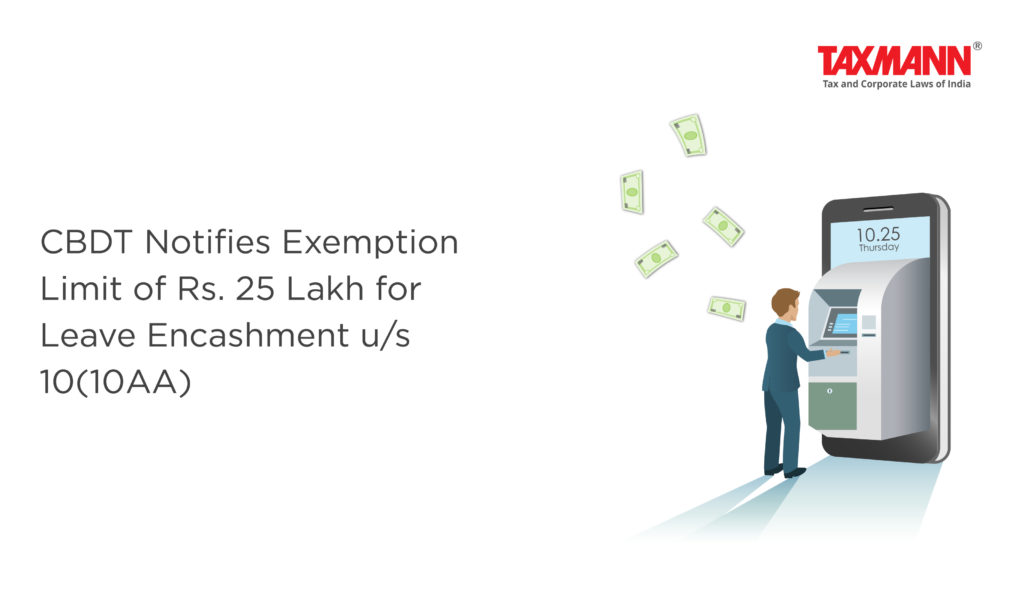CBDT Notifies Exemption Limit of Rs. 25 Lakh for Leave Encashment u/s 10(10AA)
- Blog|News|Income Tax|
- < 1 minute
- By Taxmann
- |
- Last Updated on 26 May, 2023

Notification No. 31/2023, dated 24-05-2023
When an employee surrender his unutilized leaves in lieu of monetary consideration, it is known as ‘leave encashment’.
The leaves encashed by the Government employee at retirement are fully exempt from tax. However, leaves encashed by a non-Government employee at the time of retirement (voluntary or compulsory) shall be exempt to the extent of lower of following:
a) Actual amount received in respect of encashment of leave;
b) Rs. 3,00,000; or
c) Cash equivalent for unavailed leave calculated on basis of average salary (subject to maximum 30 leaves for every completed year of services with current employer).
The limit of Rs. 3,00,000 was fixed in the year 2002 vide Notification No. SO 588(E), dated 31-5-2002, when the highest basic pay in the government was Rs. 30,000 p.m. While presenting Union Budget 2023, the Finance Minister proposed increasing the Rs. 3 lakh limit in line with the increase in government salaries.
The CBDT has issued notification increasing the Rs. 3 lakh limit to Rs. 25 lakh. The enhanced limit is effective with effect from 01-04-2023.
Click Here To Read The Full Notification
Disclaimer: The content/information published on the website is only for general information of the user and shall not be construed as legal advice. While the Taxmann has exercised reasonable efforts to ensure the veracity of information/content published, Taxmann shall be under no liability in any manner whatsoever for incorrect information, if any.

Taxmann Publications has a dedicated in-house Research & Editorial Team. This team consists of a team of Chartered Accountants, Company Secretaries, and Lawyers. This team works under the guidance and supervision of editor-in-chief Mr Rakesh Bhargava.
The Research and Editorial Team is responsible for developing reliable and accurate content for the readers. The team follows the six-sigma approach to achieve the benchmark of zero error in its publications and research platforms. The team ensures that the following publication guidelines are thoroughly followed while developing the content:
- The statutory material is obtained only from the authorized and reliable sources
- All the latest developments in the judicial and legislative fields are covered
- Prepare the analytical write-ups on current, controversial, and important issues to help the readers to understand the concept and its implications
- Every content published by Taxmann is complete, accurate and lucid
- All evidence-based statements are supported with proper reference to Section, Circular No., Notification No. or citations
- The golden rules of grammar, style and consistency are thoroughly followed
- Font and size that’s easy to read and remain consistent across all imprint and digital publications are applied



 CA | CS | CMA
CA | CS | CMA

HONOURABLE SIR,
Leave encashment benefits received by the salaried class at retirement, whose limit has been hiked from ₹3 lakh to ₹25 lakh in the Budget, will be tax-free in their hands under the new income tax regime even if they switch to it in the year of retirement, Revenue Secretary Sanjay Malhotra told. IS THIS FACILITIES ARE AVAILABLE ON ACCURAL BASIS OR PAYMENT BASIS, SUPPOSE A PERSON HAS BEEN RETAIRED FROM PSU SERVICE ON 31.10.2022 BUT HIS FINAL SETTLE WAS DONE ON 31.05.2023. MY QUESTION IS CAN HE AVAIL THE BENEFIT OF TAX EXEMPTION LIMIT RS.2500000 ON LEAVE ENCASHMENT ? THOUGH HE HAS RETAIRED FROM SERVICES ON 31.10.2022
REGARDS
Y.S.MAHAPATRA
8896600712
The Notification no. 31/2023, dated 24-05-2023 does not explicitly specify whether the applicability date should be determined based on the retirement date, the financial year starting from 01-04-2023, or the assessment year starting from 01-04-2023. In the previous Notification No. SO 588(E), dated 31-05-2002, which set a limit of Rs. 3,00,000, the applicability date was determined with reference to the retirement date. Therefore, applying the new enhanced limit of Rs. 25 lakhs would be advisable for individuals who have retired on or after 01-04-2023. For individuals who retired on or before 31-03-2023, the earlier limit of Rs. 3,00,000 will continue to apply.
HONOURABLE SIR,
Leave encashment benefits received by the salaried class at retirement, whose limit has been hiked from ₹3 lakh to ₹25 lakh in the Budget, will be tax-free in their hands under the new income tax regime even if they switch to it in the year of retirement, Revenue Secretary Sanjay Malhotra told. IS THIS FACILITIES ARE AVAILABLE ON ACCURAL BASIS OR PAYMENT BASIS, SUPPOSE A PERSON HAS BEEN RETAIRED FROM PSU SERVICE ON 31.10.2022 BUT HIS FINAL SETTLEMENT IS NOT YET DONE TILL TO DAY i.e. GRATUITY , LEAVE ENCASHMENT IS NOT YET PAID, MY QUESTION IS CAN HE AVAIL THE BENEFIT OF TAX EXEMPTION LIMIT RS.25,00,000 ON LEAVE ENCASHMENT ? THOUGH HE HAS RETAIRED FROM SERVICES ON 31.10.2022
REGARDS
Y.S.MAHAPATRA
8895500712
E MAIL ysmahapatra@yahoo.com
The Notification no. 31/2023, dated 24-05-2023 does not explicitly specify whether the applicability date should be determined based on the retirement date, the financial year starting from 01-04-2023, or the assessment year starting from 01-04-2023. In the previous Notification No. SO 588(E), dated 31-05-2002, which set a limit of Rs. 3,00,000, the applicability date was determined with reference to the retirement date. Therefore, applying the new enhanced limit of Rs. 25 lakhs would be advisable for individuals who have retired on or after 01-04-2023. For individuals who retired on or before 31-03-2023, the earlier limit of Rs. 3,00,000 will continue to apply.